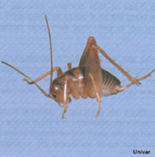Need assistance? Call 800.996.4402

Camel crickets get their common name from their humpbacked appearance, which is similar to that of a camel. They are widespread in the United States and in the world. Camel crickets do not possess sound producing organs, and therefore do not chirp. Additionally, the adults do not have wings, unlike other cricket species. Camel crickets leap when they are frightened since it’s the only defense mechanism they have to scare off predators.
Camel crickets are nocturnal, or active at night, and hide during the day. They often overwinter as young nymphs or adults. Females lay their eggs in early spring and they hatch during April.
Camel crickets do not pose any health threats to humans, but they can become a nuisance if they gain entry to the home. Some species have been known to damage clothing and other fabrics like curtains.
Camel crickets are found outdoors around buildings, typically in cool, moist environments such as under mulch, stones, railroad ties, woodpiles and debris. Around homes, they can also be found in wells and drainage pipes, or under sheds and air conditioner units.
Indoors, camel crickets are often found in damp basements, utility rooms, crawl spaces, garages and occasionally in attics. They often invade structures when it becomes hot and dry outside.
The most effective way to prevent a camel cricket infestation is to reduce areas of moisture in and around the home. A dehumidifier is recommended to prevent moisture buildup indoors. Additionally, homeowners should seal all possible points of entry around the house, keep crawl spaces, basements and attics well ventilated, and store fire wood at least 20 feet away from the house.
For the very best food safety consulting, auditing and training, please visit our strategic partner, CFS Food Safety